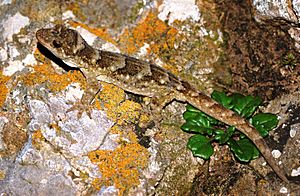Duvaucel's gecko facts for kids
Quick facts for kids Duvaucel's gecko |
|
|---|---|
 |
|
| Conservation status | |
| Scientific classification | |
| Genus: |
Hoplodactylus
|
| Species: |
duvaucelii
|
| Synonyms | |
|
|
The Duvaucel's gecko, also known as Hoplodactylus duvaucelii, is a special type of lizard found in New Zealand. It belongs to the family called Diplodactylidae. This gecko is known for being one of the largest geckos in New Zealand.
Contents
Where Do Duvaucel's Geckos Live?
Duvaucel's geckos mostly live on islands off the coast of New Zealand. These islands are safe places because they don't have many predators that would hunt the geckos. Some of these islands include Great Barrier Island and several Cook Strait islands.
In 2010, something exciting happened! A Duvaucel's gecko was found on the mainland of New Zealand at a nature reserve called Maungatautari. This discovery was very important. It showed that these geckos might still be living on the mainland, even though people thought they were only on islands. Scientists used genetic tests to confirm it was a true mainland gecko.
What Does a Duvaucel's Gecko Look Like?
Duvaucel's geckos are quite big for geckos. They can grow up to 30 centimeters (about 12 inches) long, including their tail. They can also weigh up to 120 grams (about 4.2 ounces). This makes them the largest living gecko in New Zealand.
These geckos have a strong, heavy body and a fairly large head. Their toes are long and have special pads that help them climb. Their main color is grey, but they often have a slight olive-green tint. They usually have six uneven blotches across their body, from behind their head to the base of their tail. Their tail never has stripes. These geckos can live a long time; the oldest known wild Duvaucel's gecko was at least 36 years old!
Duvaucel's Gecko Habits and Life
Duvaucel's geckos are mostly nocturnal, which means they are active at night. However, sometimes you might see them basking in the sun to warm up. They like to eat large insects, such as puriri moths and wētā.
Scientists believe that Duvaucel's geckos used to live in many more places. But over time, animals brought to New Zealand by humans, like rats and stoats, hunted them. This caused the gecko's population to shrink to mostly the offshore islands.
These geckos live both on the ground and in trees. They can be found in bushes, forests, and even along the shorelines of the islands where they live. Unlike many other lizards, female Duvaucel's geckos do not lay eggs. Instead, they give birth to live baby geckos.
How Did the Duvaucel's Gecko Get Its Name?
The scientific name Hoplodactylus duvaucelii was given by mistake. It was named after Alfred Duvaucel, a French naturalist. He explored India, and some museum specimens were wrongly credited to him. Later, it was discovered that these geckos actually came from New Zealand, not India.
Helping Duvaucel's Geckos Survive
People are working hard to protect Duvaucel's geckos. At the end of 2016, 80 geckos were moved back to the mainland of New Zealand. They were released into the Tāwharanui Open Sanctuary on the Tawharanui Peninsula. This special sanctuary is a safe place where predators are controlled. This effort helps to bring these amazing geckos back to their original homes and ensure their future.


